weight CHEVROLET EXPRESS 1998 1.G Owners Manual
[x] Cancel search | Manufacturer: CHEVROLET, Model Year: 1998, Model line: EXPRESS, Model: CHEVROLET EXPRESS 1998 1.GPages: 386, PDF Size: 20.74 MB
Page 53 of 386
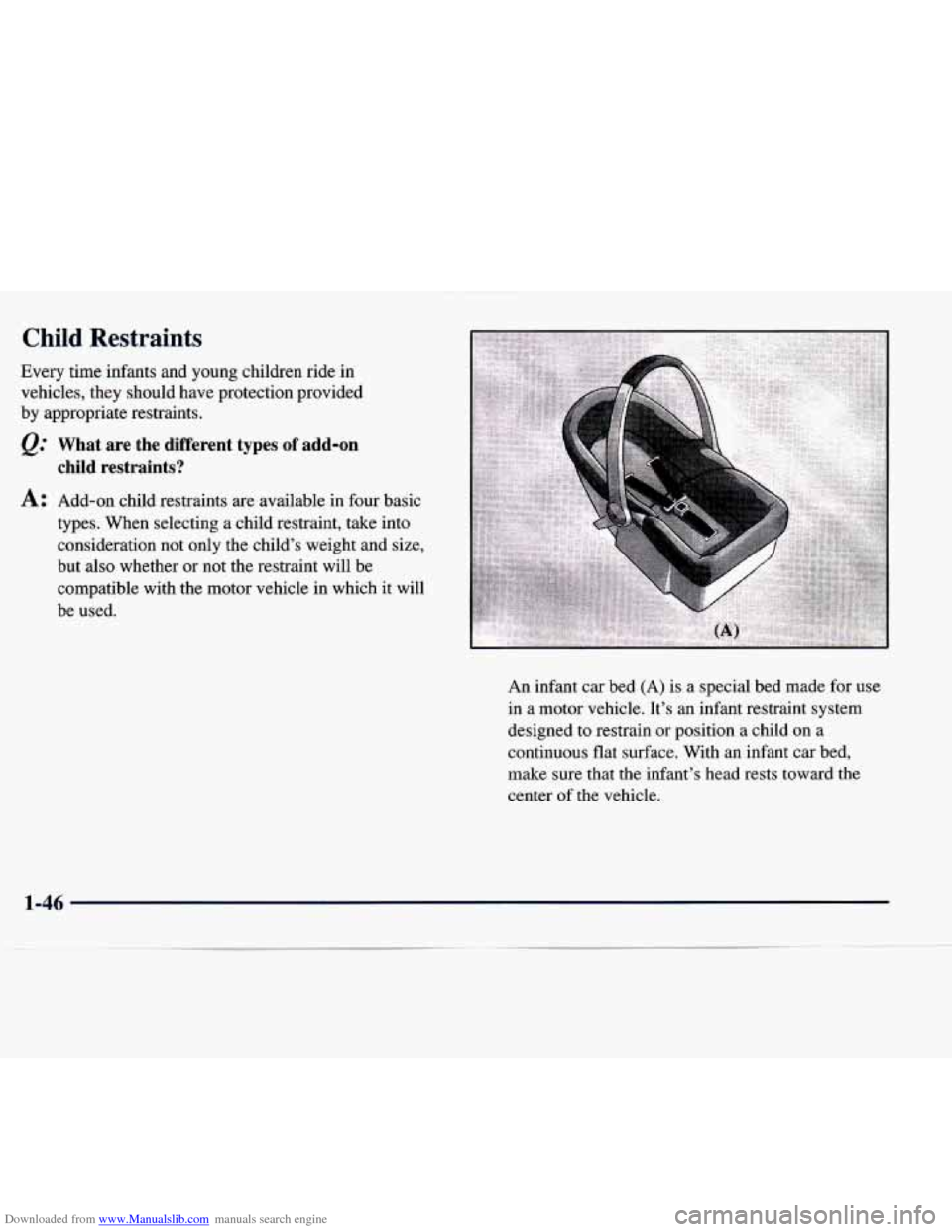
Downloaded from www.Manualslib.com manuals search engine Child Restraints
Every time infants and young children ride in
vehicles, they should have protection provided
by appropriate restraints.
@ What are the different types of add-on
A: Add-on child restraints are available in four basic
types. When selecting a child restraint,
take into
consideration not only the child’s weight and size,
but also whether or not the restraint will be
compatible with the motor vehicle in which it will
be used.
child restraints?
An infant car bed (A) is a special bed made for use
in a motor vehicle. It’s an infant restraint system
designed to restrain or position a child on a
continuous flat surface. With an infant car bed,
make
sure that the infant’s head rests toward the
center of the vehicle.
1-46
Page 98 of 386
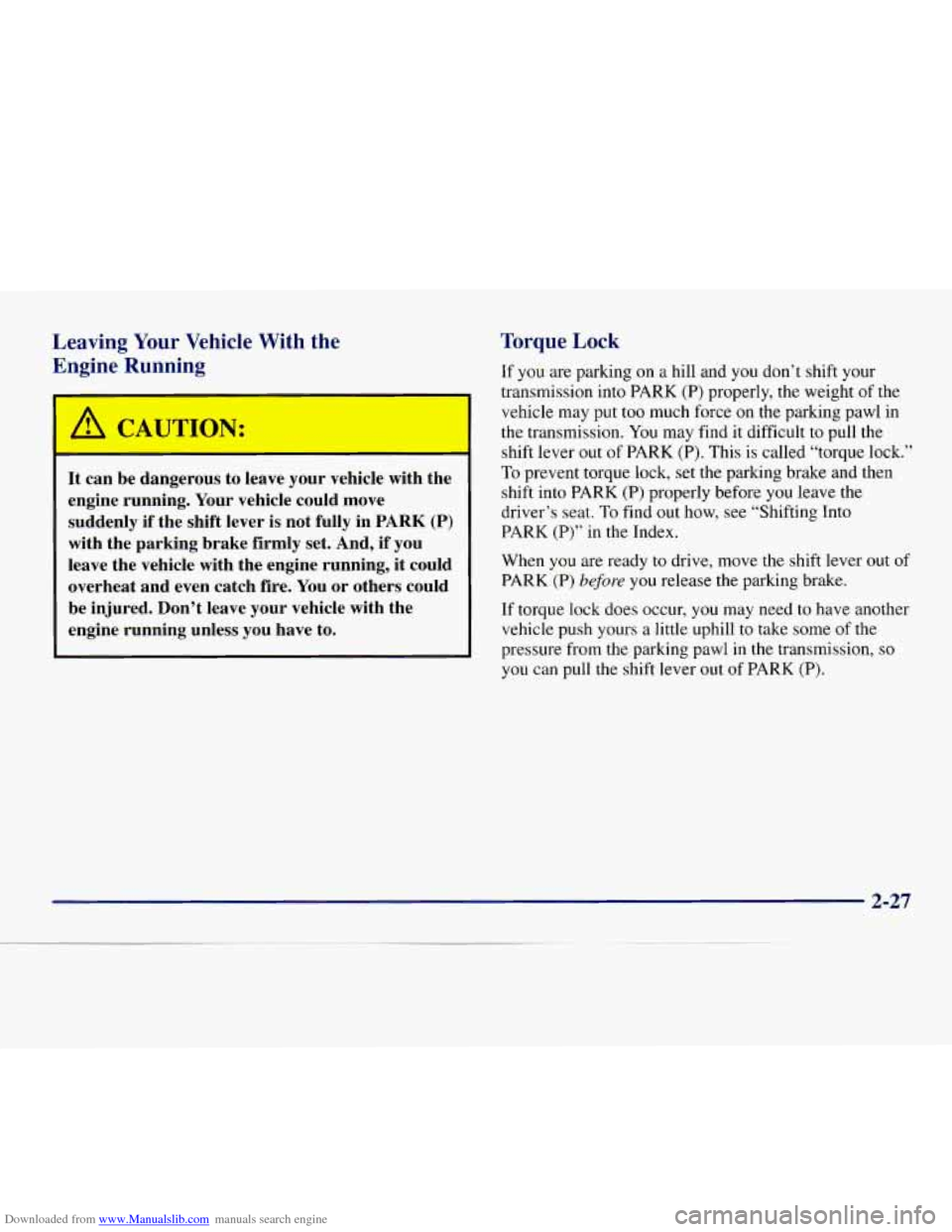
Downloaded from www.Manualslib.com manuals search engine Leaving Your Vehicle With the
Engine Running
I A CAUTION:
It can be dangerous to leave your vehicle with the
engine running. Your vehicle could move
suddenly if the shift lever
is not fully in PARK (P)
with the parking brake firmly set. And, if you
leave the vehicle with the engine running, it could
overheat and even catch fire.
You or others could
be injured. Don’t leave your vehicle with the
engine running unless you have to.
Torque Lock
If you are parking on a hill and you don’t shift your
transmission into PARK (P) properly, the weight of the
vehicle may put
too much force on the parking pawl in
the transmission. You may find it difficult to pull the
shift lever out of PARK
(P). This is called “torque lock.”
To prevent torque lock, set the parking brake and then
shift into
PARK (P) properly before you leave the
driver’s seat.
To find out how, see “Shifting Into
PARK (P)” in the Index.
When you are ready
to drive, move the shift lever out of
PARK (P) before you release the parking brake.
If torque
lock does occur, you may need to have another
vehicle push yours
a little uphill to take some of the
pressure from the parking pawl in the transmission,
so
you can pull the shift lever out of PARK (P).
Page 166 of 386
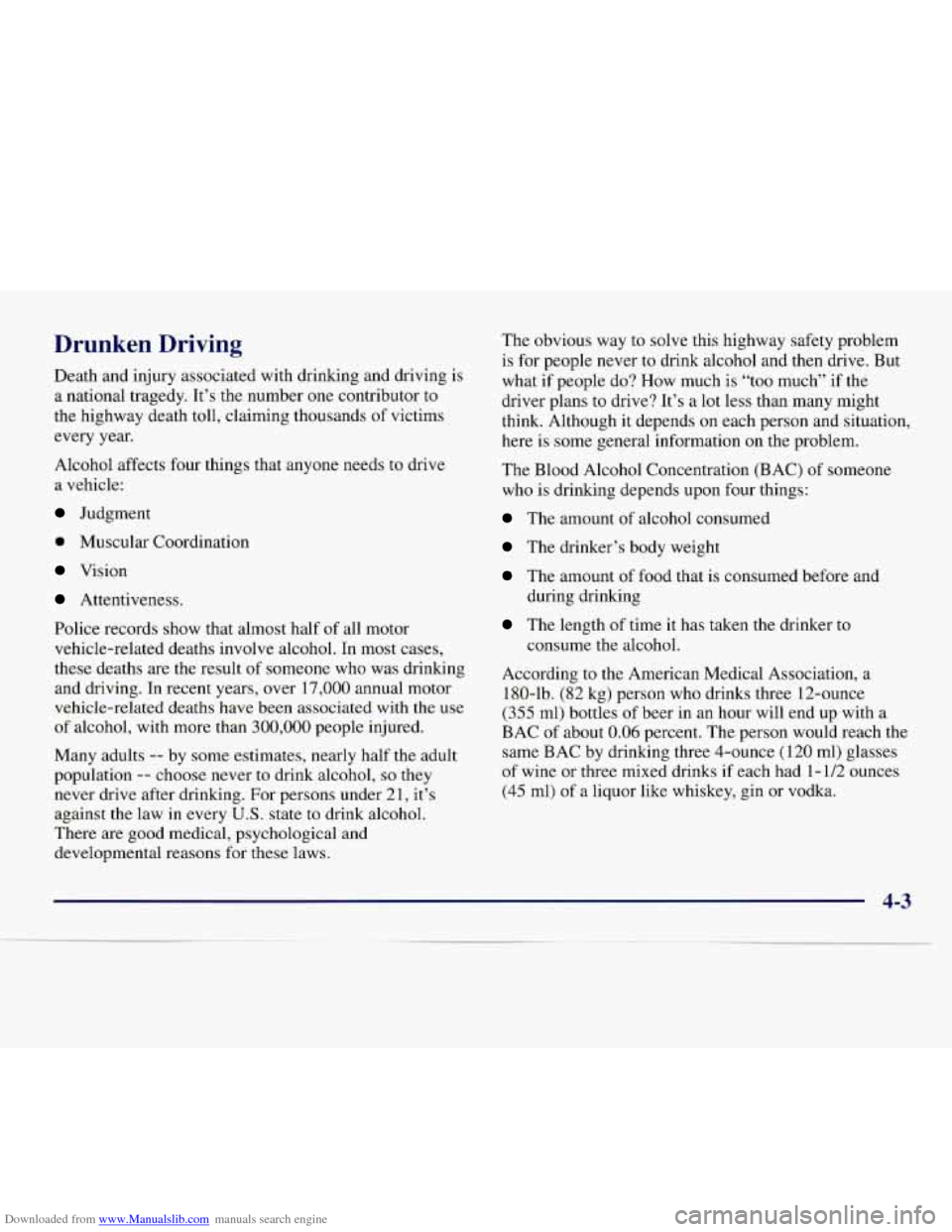
Downloaded from www.Manualslib.com manuals search engine Drunken Driving
Death and injury associated with drinking and driving is
a national tragedy. It’s the number one contributor to
the highway death toll, claiming thousands of victims
every
year.
Alcohol affects four things that anyone needs to drive
a vehicle:
Judgment
@ Muscular Coordination
Vision
Attentiveness.
Police records show that almost half of all motor
vehicle-related deaths involve alcohol. In most cases,
these deaths are the result
of someone who was drinking
and driving. In recent years, over 17,000 annual motor
vehicle-related deaths have been associated with the use
of alcohol, with more than
300,000 people injured.
Many adults
-- by some estimates, nearly half the adult
population
-- choose never to drink alcohol, so they
never drive after drinking. For persons under
21, it’s
against the law in every
U.S. state to drink alcohol.
There are good medical, psychological and
developmental reasons for these laws. The obvious
way
to solve this highway safety problem
is for people never to drink alcohol and then drive. But
what
if people do? How much is “too much’ if the
driver plans to drive? It’s a lot less than many might
think. Although it depends on each person and situation,
here is some general information on the problem.
The Blood Alcohol Concentration (BAC)
of someone
who is drinking depends upon four things:
The amount of alcohol consumed
The drinker’s body weight
The amount of food that is consumed before and
during drinking
The length of time it has taken the drinker to
consume the alcohol.
According
to the American Medical Association, a
180-lb. (82
kg) person who drinks three 12-ounce
(355 ml) bottles of beer in an hour will end up with a
BAC of about
0.06 percent. The person would reach the
same BAC by drinking three 4-ounce (120 ml) glasses
of wine or three mixed drinks if each had
1- 1/2 ounces
(45 ml) of a liquor like whiskey, gin or vodka.
4-3
Page 167 of 386
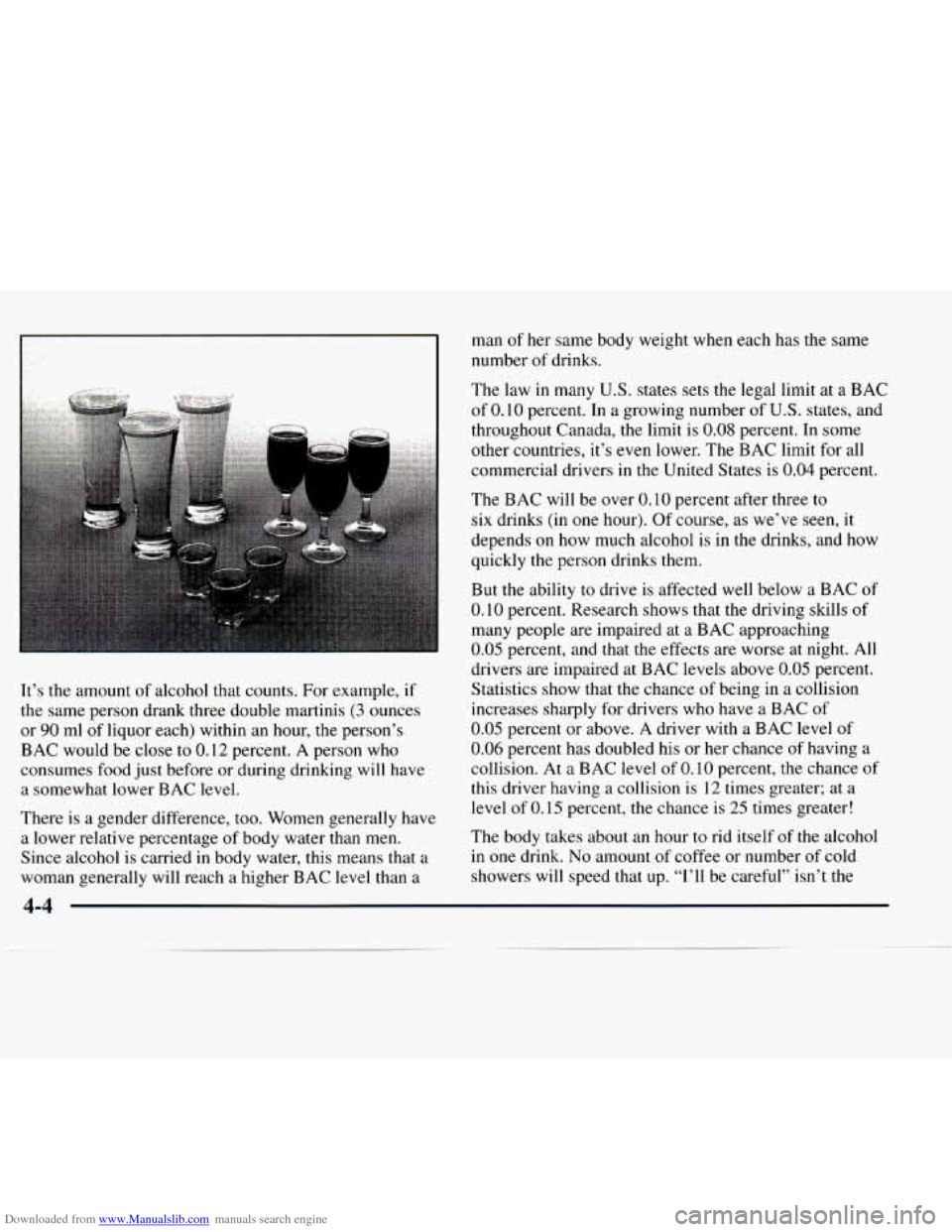
Downloaded from www.Manualslib.com manuals search engine It’s the amount of alcohol that counts. For example, if
the same person drank three double martinis (3 ounces
or
90 ml of liquor each) within an hour, the person’s
BAC would be
close to 0.12 percent. A person who
consumes food just before or during drinking will have
a somewhat lower BAC level.
There is
a gender difference, too. Women generally have
a lower relative percentage
of body water than men.
Since alcohol is carried
in body water, this means that a
woman generally will reach a higher BAC level than a man
of her
same body weight when each has the same
number of drinks.
The law
in many U.S. states sets the legal limit at a BAC
of 0.10 percent. In a growing number of
U.S. states, and
throughout Canada, the limit is
0.08 percent. In some
other countries, it’s even lower. The BAC limit for all
commercial drivers in the United States is
0.04 percent.
The BAC will be over
0.10 percent after three to
six drinks (in one hour). Of course, as we’ve seen, it
depends on how much alcohol is in the drinks, and how
quickly the person drinks them.
But the ability to drive is affected well below a BAC
of
0.10 percent. Research shows that the driving skills of
many people are impaired at a BAC approaching
0.05 percent, and that the effects are worse at night. All
drivers are impaired at BAC levels above
0.05 percent.
Statistics show that the chance of being in
a collision
increases sharply for drivers who have a BAC of
0.05 percent or above. A driver with a BAC level of
0.06 percent has doubled his or her chance of having a
collision. At a BAC level of
0.10 percent, the chance of
this driver having a collision is 12 times greater; at a
level
of 0.15 percent, the chance is 25 times greater!
The body takes about an hour
to rid itself of the alcohol
in one drink.
No amount of coffee or number of cold
showers will speed that up. “I’ll be careful’’ isn’\
t the
Page 169 of 386
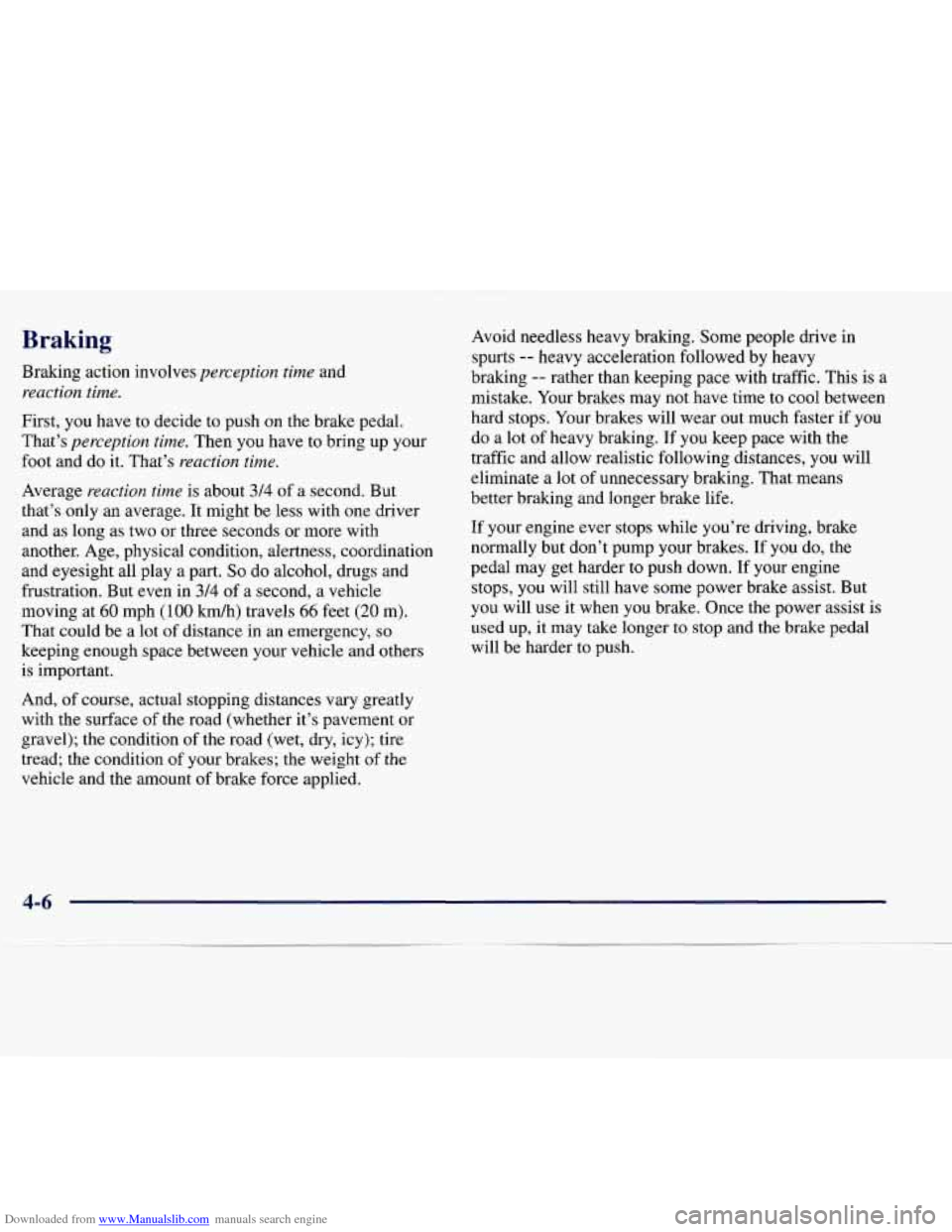
Downloaded from www.Manualslib.com manuals search engine Braking
Braking action involves perception time and
reaction time.
First, you have to decide to push on the brake pedal.
That’s
perception time. Then you have to bring up your
foot and do it. That’s
reaction time.
Average reaction time is about 3/4 of a second. But
that’s only an average. It might be less with one driver
and as long as two or three seconds or more with
another. Age, physical condition, alertness, coordination
and eyesight all play a part.
So do alcohol, drugs and
frustration. But even
in 3/4 of a second, a vehicle
moving at
60 mph (100 kdh) travels 66 feet (20 m).
That could be a lot
of distance in an emergency, so
keeping enough space between your vehicle and others
is important.
And,
of course, actual stopping distances vary greatly
with the surface of the road (whether it’s pavement or
gravel); the condition
of the road (wet, dry, icy); tire
tread; the condition
of your brakes; the weight of the
vehicle and the amount of brake force applied. Avoid needless heavy braking. Some people
drive in
spurts
-- heavy acceleration followed by heavy
braking
-- rather than keeping pace with traffic. This is a
mistake. Your brakes may not have time to cool between
hard stops. Your brakes will wear out much faster if you
do a lot of heavy braking.
If you keep pace with the
traffic and allow realistic following distances, you will
eliminate
a lot of unnecessary braking. That means
better braking and longer brake life.
If your engine ever stops while you’re driving, brake
normally but don’t pump your brakes. If you do, the
pedal may get harder to push down. If your engine
stops,
you will still have some power brake assist. But
you will use it when you brake. Once the power assist
is
used up, it may take longer to stop and the brake pedal
will be harder to push.
4-6
Page 190 of 386
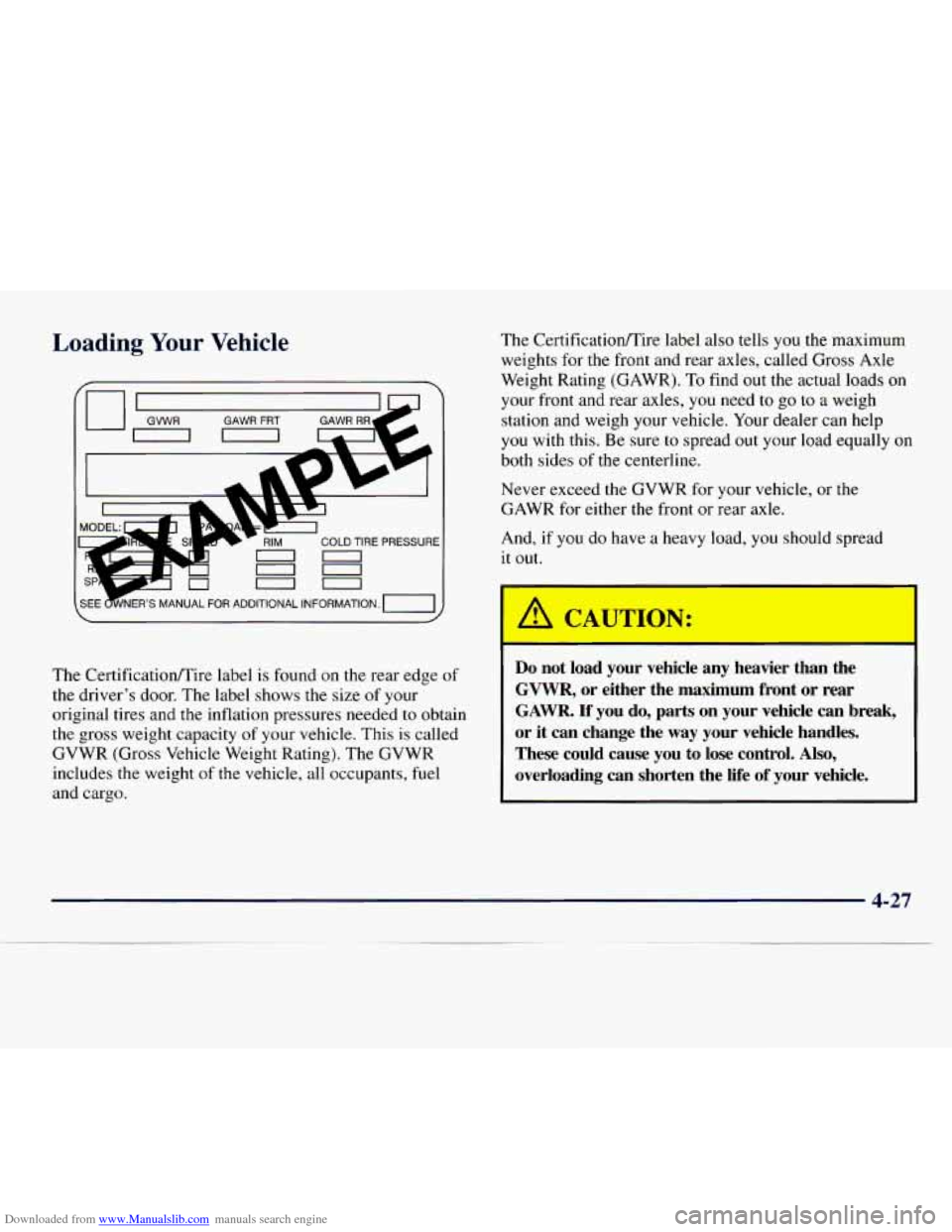
Downloaded from www.Manualslib.com manuals search engine Loading Your Vehicle
COLD TIRE PRESSURE
The Certificationrnire label is found on the rear edge of
the driver's door. The label shows the size
of your
original tires and the inflation pressures needed to obtain
the gross weight capacity of your vehicle. This is called
GVWR (Gross Vehicle Weight Rating). The GVWR
includes the weight of the vehicle, all occupants, fuel
and cargo. The
Certificatioflire label also tells you the maximum
weights for the front and rear axles, called
Gross Axle
Weight Rating (GAWR).
To find out the actual loads on
your front and rear axles, you need to go to a weigh
station and weigh your vehicle. Your dealer can help
you with
this. Be sure to spread out your load equally on
both sides of the centerline.
Never exceed the GVWR for your vehicle, or the
GAWR
for either the front or rear axle.
And, if you do have a heavy load, you should spread
it out.
I
I
A QUI 0 :
Do not load your vehicle any heavier than the
GVWR, or either the maximum front or rear
GAWR. If you do, parts on your vehicle can break,
or
it can change the way your vehicle handles.
These could cause you to lose control.
Also,
overloading can shorten the life of your vehicle.
4-27
Page 191 of 386
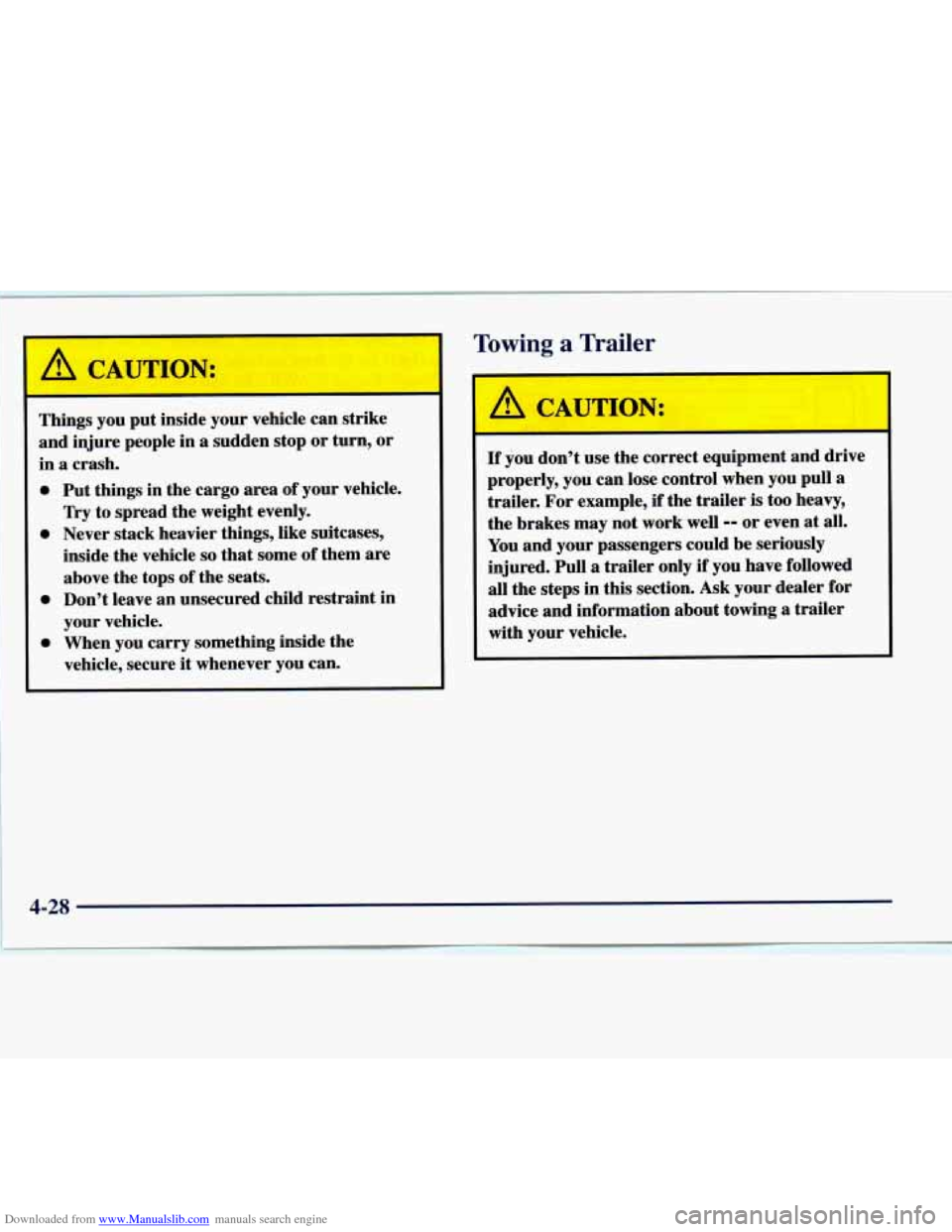
Downloaded from www.Manualslib.com manuals search engine Things you put inside your vehicle can strike
and injure people in a sudden stop or turn, or
in a crash.
0 Put things in the cargo area of your vehicle.
0 Never stack heavier things, like suitcases,
Try
to spread the weight evenly.
inside the vehicle
so that some of them are
above the tops of the seats.
0 Don’t leave an unsecured child restraint in
your vehicle.
0 When you carry something inside the
vehicle, secure
it whenever you can.
Towing a Trailer
,- CAUTION:
If you don’t use the correct equipment and drive
properly, you can lose control when you pull
a
trailer. For example, if the trailer is too heavy,
the brakes may not work well
-- or even at all.
You and your passengers could be seriously
injured. Pull
a trailer only if you have followed
all the steps in this section. Ask your dealer for
advice and information about towing
a trailer
with your vehicle.
4-28
Page 192 of 386
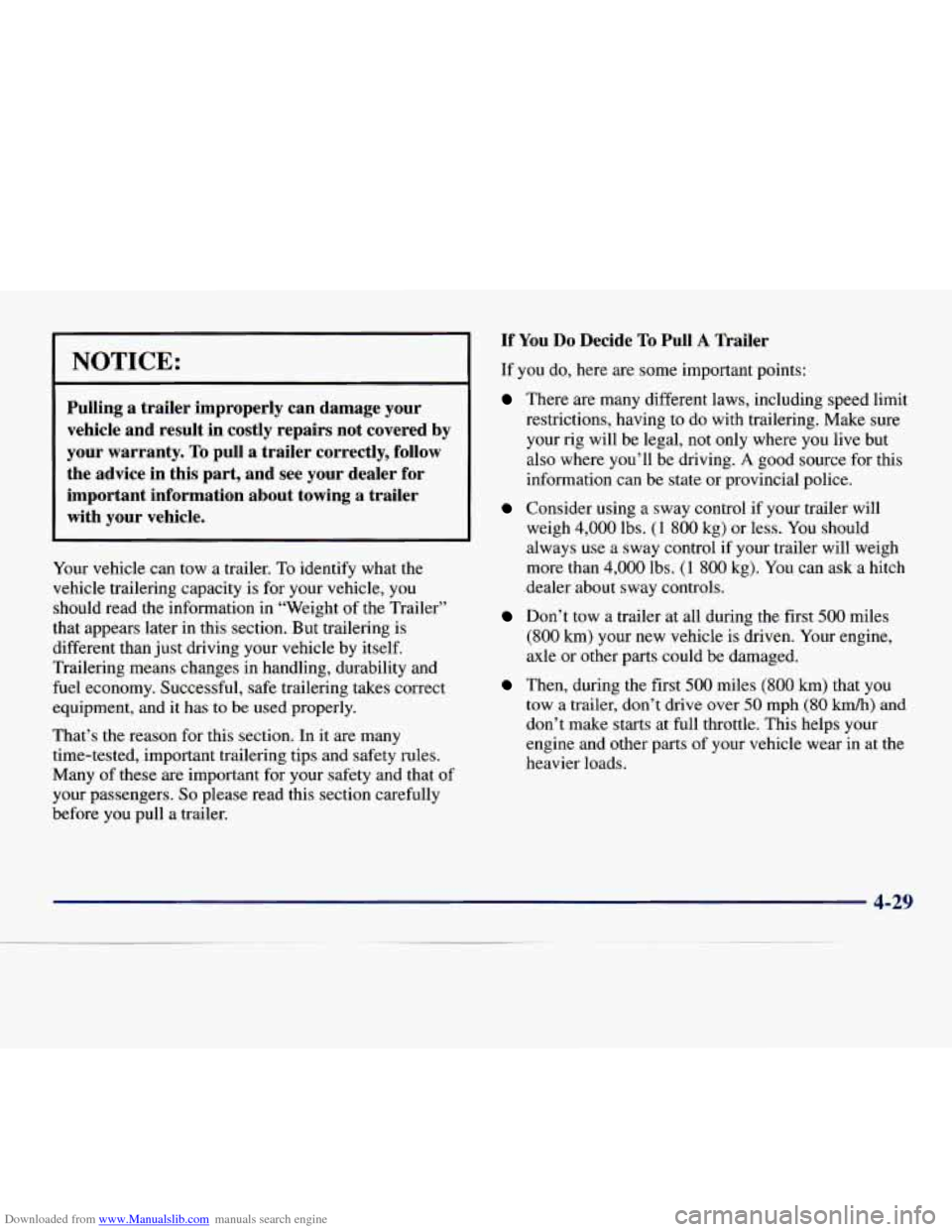
Downloaded from www.Manualslib.com manuals search engine I NOTICE:
Pulling a trailer improperly can damage your
vehicle and result in costly repairs not covered by
your warranty.
To pull a trailer correctly, follow
the advice in this part, and see your dealer for important information about towing a trailer
with your vehicle.
Your vehicle can tow a trailer. To identify what the
vehicle trailering capacity is for your vehicle, you
should read the information in “Weight of the Trailer”
that appears later in this section. But trailering is
different than just driving your vehicle by itself.
Trailering means changes in handling, durability and
fuel economy. Successful, safe trailering takes correct
equipment, and it has to be used properly.
That’s the reason for this section. In it are many
time-tested, important trailering tips and safety rules.
Many of these are important for your safety and that
of
your passengers. So please read this section carefully
before you pull a trailer.
If You Do Decide To Pull A Trailer
If you do, here are some important points:
There are many different laws, including speed limit
restrictions, having to do with trailering. Make sure
your rig will be legal, not only where you live but
also where you’ll be driving.
A good source for this
information can be state or provincial police.
Consider using a sway control if your trailer will
weigh
4,000 lbs. (1 800 kg) or less. You should
always use a sway control
if your trailer will weigh
more than
4,000 lbs. (1 800 kg). You can ask a hitch
dealer about sway controls.
Don’t tow a trailer at all during the first 500 miles
(800 km) your new vehicle is driven. Your engine,
axle or other parts could be damaged.
Then, during the first 500 miles (800 km) that you
tow a trailer, don’t drive over 50 mph (80 kmh) and
don’t make starts
at full throttle. This helps your
engine and other parts of your vehicle wear
in at the
heavier loads.
4-29
Page 193 of 386
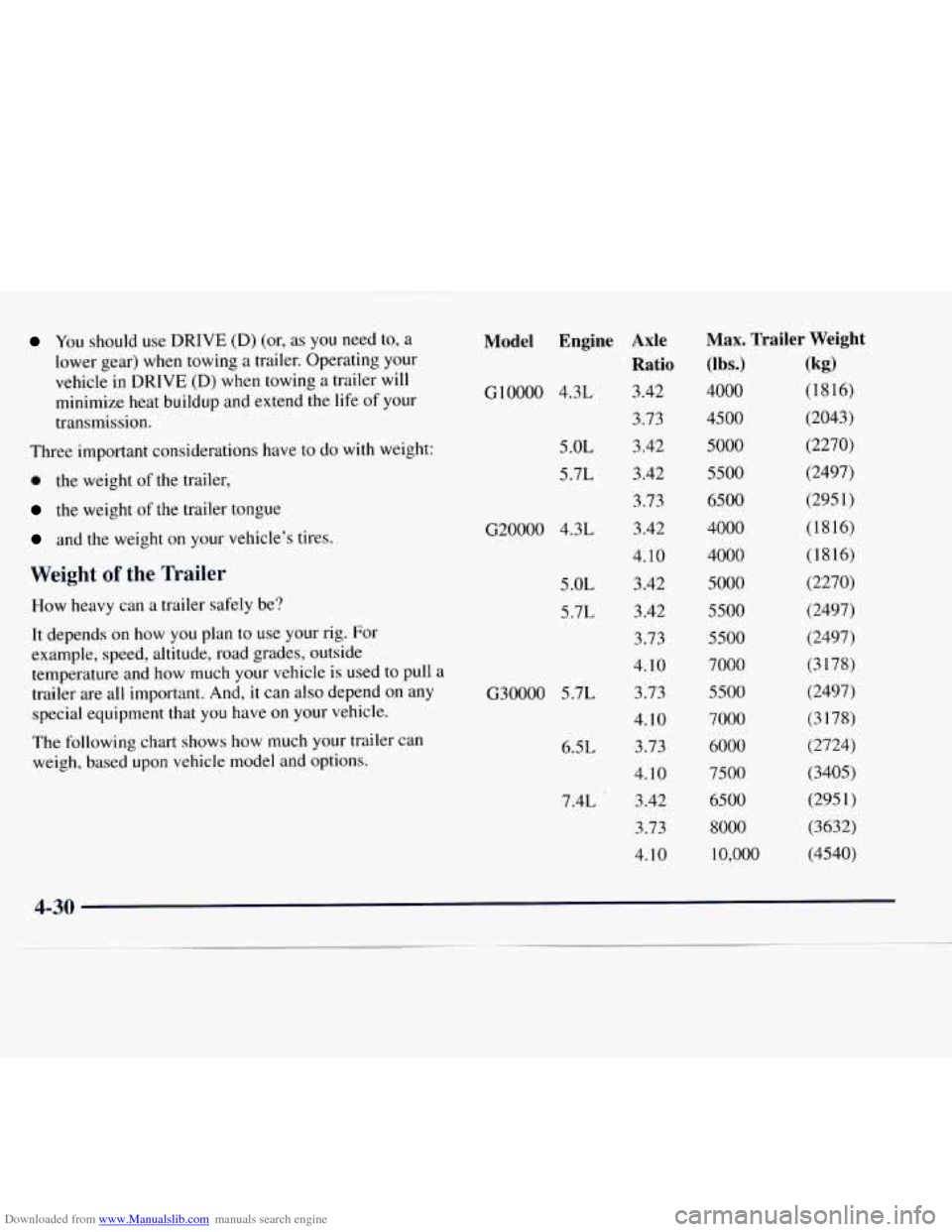
Downloaded from www.Manualslib.com manuals search engine You should use DRIVE (D) (or, as you need to, a
lower gear) when towing a trailer. Operating your
vehicle
in DRIVE (D) when towing a trailer will
minimize heat buildup and extend the
life of your
transmission.
Three important considerations have to do with weight:
0 the weight of the trailer,
the weight of the trailer tongue
and the weight on your vehicle’s tires.
Weight of the Trailer
How heavy can a trailer safely be?
It depends on how you plan to use your rig. For
example, speed, altitude, road grades, outside
temperature and how much your vehicle is used to pull a
trailer are all important. And, it can also depend
on any
special equipment that you have
on your vehicle.
The following chart shows
how much your trailer can
weigh, based upon vehicle model and options. GlOOOO
4.3L
5 .OL
5.7L
G20000 4.3L
Model Engine Axle
Ratio
3.42
3.73
3.42
3.42 3.73
3.42
4.10
5 .OL 3.42
5.7L 3.42
3.73
4.10
3.73
4.10 3.73
4.10
3.42
3.73
4.10
G30000 5.7L
6.5L
7.4L
Max. Trailer Weight (lbs.)
(kg)
4000 (1 816)
4500 (2043) 5000 (2270)
5500 (2497)
6500 (295
1)
4000 (1816)
4000 (1816)
5000 (2270)
5500 (2497) 5500 (2497)
7000 (3
178)
5500 (2497)
7000 (3 178)
6000 (2724)
7500 (3405)
6500 (295 1)
8000 (3632)
10,000 (4540)
4-30
Page 194 of 386
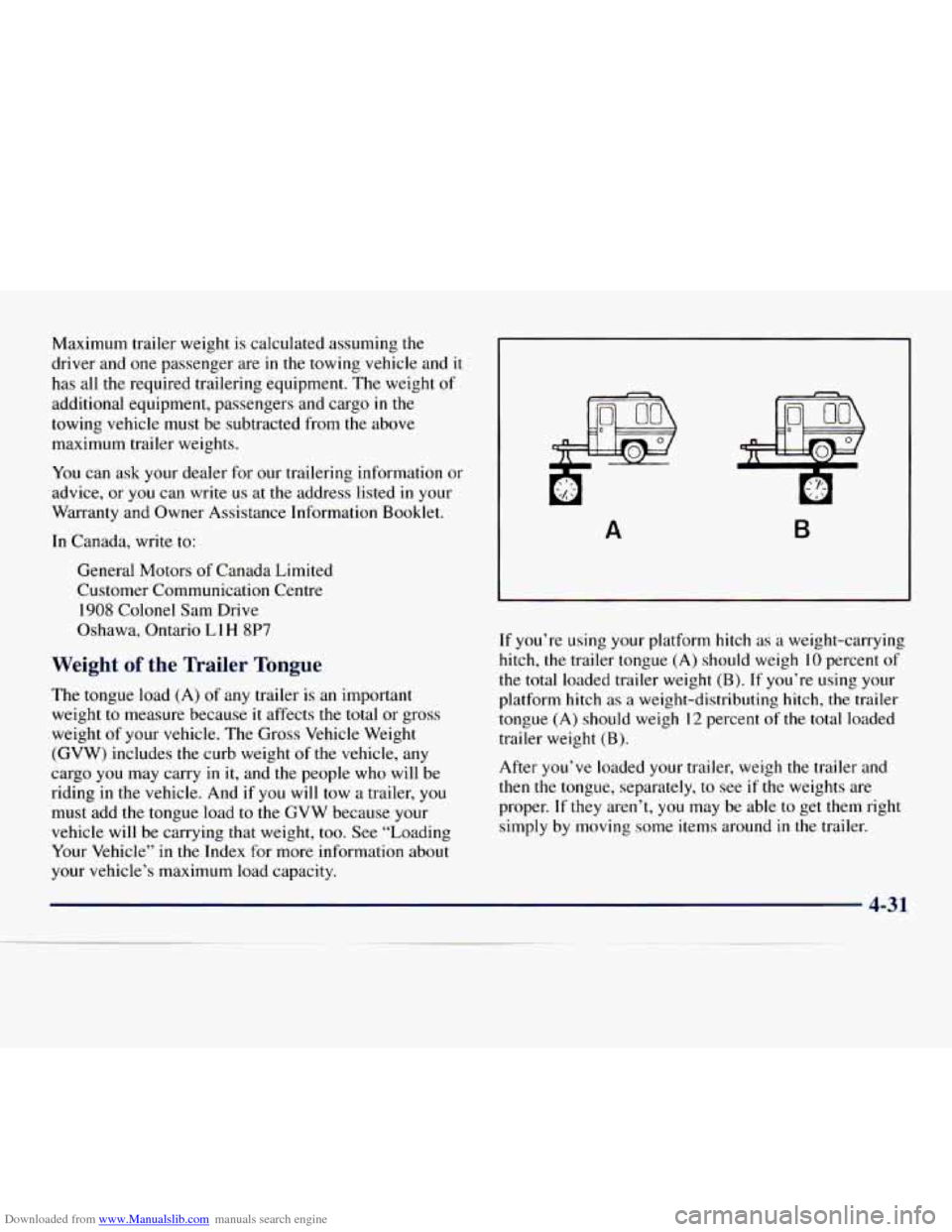
Downloaded from www.Manualslib.com manuals search engine Maximum trailer weight is calculated assuming the
driver and
one passenger are in the towing vehicle and it
has all the required trailering equipment.
The weight of
additional equipment, passengers and cargo
in the
towing vehicle must be subtracted from
the above
maximum trailer weights.
You can ask your dealer for our trailering information or
advice, or you can write
us at the address listed in your
Warranty and Owner Assistance Information Booklet.
In Canada, write to:
General Motors
of Canada Limited
Customer Communication Centre
1908 Colonel Sam Drive
Oshawa, Ontario
L 1 H 8P7
Weight of the Trailer Tongue
The tongue load (A) of any trailer is an important
weight to measure because
it affects the total or gross
weight of your vehicle. The Gross Vehicle Weight
(GVW) includes the curb weight of the vehicle, any
cargo you may carry in
it, and the people who will be
riding in the vehicle. And if
you will tow a trailer, you
must add the tongue load to the GVW because your
vehicle will be carrying that weight,
too. See “Loading
Your Vehicle” in the Index for more information about
your vehicle’s maximum load capacity.
A B
If you’re using your platform hitch as a weight-carrying
hitch,
the trailer tongue (A) should weigh 10 percent of
the total loaded trailer weight
(B). If you’re using your
platform hitch as a weight-distributing hitch, the trailer
tongue
(A) should weigh 12 percent of the total loaded
trailer weight
(B).
After you’ve loaded your trailer, weigh the trailer and
then
the tongue, separately, to see if the weights are
proper. If they aren’t, you may be able to get
them right
simply by moving some items around
in the trailer.